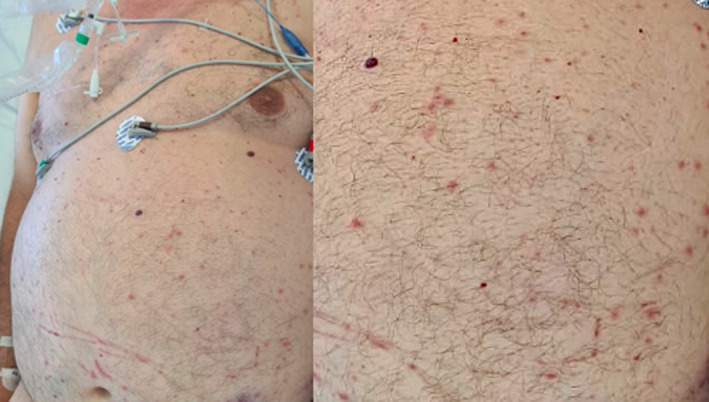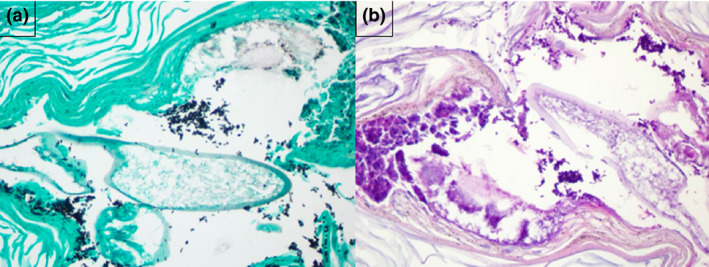Conflict of interest
I hereby declare that the manuscript authors have no conflicts of interest.
Dear Editor,
During the Coronavirus disease 2019 (COVID‐19) pandemic, dermatologists are dealing with challenging clinical scenarios in their clinical practice. A wide range of cutaneous manifestations has been described, either directly associated with the COVID‐19, or as a consequence of management procedures, as well as an exacerbation of previous cutaneous conditions. 1
We have read with great interest the paper published by Barrera‐Godinez et al., 2 in which they mention Pityrosporum folliculitis in COVID‐19 patients. We have recently evaluated three patients in the intensive care unit (ICU), diagnosed with COVID‐19 acute respiratory distress syndrome (ARDS) presenting similar cutaneous manifestations.
Initially, we were called to evaluate a 52‐year‐old obese man, with type 2 diabetes, under mechanical ventilation in a prone position and receiving systemic corticosteroids, due to a severe COVID‐19 ARDS. He had also evolved with acute renal failure and septic complications (ventilator‐associated pneumonia and septic shock by bloodstream infection), using several systemic antibiotics. A monomorphic eruption of follicular erythematous papules and pustules was observed on the chest, upper and lower limbs, on the back and abdomen after 6 days in the ICU. We also examined a 46‐year‐old obese man, with no other comorbidities, recovering from a severe COVID‐19 ARDS, still using systemic corticosteroids and vancomycin due to septic complications, but no longer under mechanical ventilation. A monomorphic eruption of erythematous follicular papules and pustules on the chest, abdomen, back and upper limbs was also observed, starting after 10 days in the ICU. The third patient was a 39‐year‐old obese man also recovering from a severe COVID‐19 ARDS, still using systemic corticosteroids and receiving broad‐spectrum antibiotic therapy due to ventilator‐associated pneumonia. Almost one month after hospitalization, erythematous papules and pustules were noticed on the anterior thorax, abdomen, back and upper limbs (Fig. 1). Histologic examination of all patients revealed a chronic suppurative folliculitis with Pityrosporum species visualized periodic acid–Schiff (PAS) and Grocott stain (Fig. 2).
Figure 1.

Erythematous follicular papules observed on the anterior thoracic and abdominal regions of the third patient.
Figure 2.

Pityrosporum species visualized with Grocott (a) and PAS (b).
Pityrosporum folliculitis is characterized by overgrowth of yeasts of Malassezia family, causing inflammation in the hair follicles that occurs due to a modification of the cutaneous flora. 3 , 4 As observed in our patients, it presents as an acneiform eruption, commonly affecting trunk and upper limbs. 3 , 4 , 5 , 6 It is often pruritic, 4 , 5 , 6 although in critical patients to evaluate this symptom might depend on their level of consciousness.
The patients described above presented several potential predisposing factors for Pityrosporum folliculitis, such as the use of broad‐spectrum systemic antibiotic regimens that affect normal cutaneous flora, the use of systemic corticosteroids, which potentially affects host defence mechanisms and episodes of increased sweating that are common in prolonged ICU hospitalizations. 4 , 5 , 6 Obesity, another common clinical aspect presented in our patients, is a well‐known risk factor for the development of cutaneous infections such as folliculitis. 7
Pityrosporum folliculitis might be frequently misdiagnosed with other follicular eruptions. 3 , 4 , 5 , 6 In the scenario of critically ill COVID‐19 patients, other causes for the presence of a monomorphic eruption of erythematous follicular papules and pustules may be considered, such as bacterial folliculitis, acneiform eruption induced by systemic corticosteroid therapy, acute generalized exanthematous pustulosis (AGEP) and a cutaneous eruption due to the COVID‐19 infection. 2 , 8 Histopathology may be crucial to confirm the diagnosis and to rule out other causes. 4 , 5 , 9
Barrera‐Godinez et al. 2 have recently reported that Pityrosporum folliculitis may be found in COVID‐19 patients. Our report reinforces that this association is probably frequent and that clinicians might consider the diagnosis of Pityrosporum folliculitis in patients presenting a monomorphic eruption of erythematous follicular papules and pustules, especially on the trunk, following the use of systemic corticosteroids and broad‐spectrum antibiotics for severe COVID‐19 ARDS.
Funding sources
I hereby declare that no funding sources support this work.
Acknowledgement
The patients in this manuscript have given written informed consent to the publication of their case details.
Data Availability Statement
Data are openly available in a public repository that issues datasets with DOIs.
References
- 1. Darlenski R, Tsankov N. COVID‐19 pandemic and the skin: what should dermatologists know? Clin Dermatol 2020; 38: 785–787. [DOI] [PMC free article] [PubMed] [Google Scholar]
- 2. Barrera‐Godínez A, Flores SM, Torres MG et al. Not all that glitters is COVID‐19: a case series demonstrating the need for histopathology when skin findings accompany SARS‐CoV‐2 infection. J Eur Acad Dermatol Venereol 2021; 35: 1865–1873. [DOI] [PMC free article] [PubMed] [Google Scholar]
- 3. Prindaville B, Belazarian L, Levin NA, Wiss K. Pityrosporum folliculitis: a retrospective review of 110 cases. J Am Acad Dermatol 2018; 78: 511–514. [DOI] [PubMed] [Google Scholar]
- 4. Rubenstein RM, Malerich SA. Malassezia (Pityrosporum) folliculitis. J Clin Aesthet Dermatol 2014; 7: 37–41. [PMC free article] [PubMed] [Google Scholar]
- 5. Cohen PR, Erickson C, Calame A. Malassezia (Pityrosporum) folliculitis incognito: Malesseziaassociated folliculitis masked by topical corticosteroid therapy. Cureus 2020; 12: e6531. [DOI] [PMC free article] [PubMed] [Google Scholar]
- 6. Ayers K, Sweeney SM, Wiss K. Pityrosporum folliculitis: diagnosis and management in 6 female adolescents with acne vulgaris. Arch Pediatr Adolesc Med 2005; 159: 64–67. [DOI] [PubMed] [Google Scholar]
- 7. Scheinfeld NS. Obesity and dermatology. Clin Dermatol 2004; 22: 303–309. [DOI] [PubMed] [Google Scholar]
- 8. Mengesha YM, Bennett ML. Pustular skin disorders: diagnosis and treatment. Am J Clin Dermatol 2002; 3: 389–400. [DOI] [PubMed] [Google Scholar]
- 9. Durdu M, Guran M, Ilkit M. Epidemiological characteristics of Malassezia folliculitis and use of the May‐Grünwald‐Giemsa stain to diagnose the infection. Diagn Microbiol Infect Dis 2013; 76: 450–457. [DOI] [PubMed] [Google Scholar]
Associated Data
This section collects any data citations, data availability statements, or supplementary materials included in this article.
Data Availability Statement
Data are openly available in a public repository that issues datasets with DOIs.


